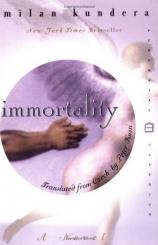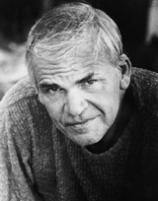Reading Group Guide
Discussion Questions
Immortality

1. What significance does Kundera ascribe to immortality? Goethe tells Hemingway, "Immortality means eternal trial." In what ways might this be true, not only for such famous artists as Goethe, Hemingway, and Beethoven, but for Agnes, Paul, and each of us? How do Kundera's "minor immortality," "great immortality," and "ridiculous immortality" differ, from each other?
2. What roles does death play in the novel? What kinds of death occur, and what is the importance of each? In what ways does death "form an inseparable pair" with immortality?
3. Kundera writes, "Without the faith that our face expresses our self, without that basic illusion, that archillusion, we cannot live, or at least we cannot take life seriously." In what ways do the concept of the individual self and its expression gather importance in the novel? How does a notion of one's self ("mere illusion, ungraspable, indescribable," claims Paul) differ from a notion of one's image in the eyes of others ("the only reality, all too easily graspable and describable")?
4. What is the importance of solitude to Agnes and to other characters? What does it consist of for each? How is solitude related to the longing for immortality? What is the importance of the distinction that Agnes makes between living and being?
5. In the sections dealing with Goethe and Hemingway and those dealing with Agnes, Paul, and Laura, celebrity and fame take on increasing importance. To what extent is immortality a function of celebrity? Has celebrity replaced immortality in the twentieth century? If so, with what consequences?
6. Agnes's and Paul's differing attitudes toward their bodies, we are told, "revealed the difference between the male and female lot in life." What aspects of that difference does Kundera identify? To what extent -- and why -- do you agree or disagree with Kundera's understanding of that difference?
7. What is the "gradual, general, planetary transformation of ideology into imagology" about which Kundera writes in Part Three? What does he mean by "imagology"? How does he see it as characterizing our time? What effects does it have on individuals, politics, the arts, and society in general?
8. Do you agree or disagree -- and why -- with what appears to be Kundera's final judgment, prompted by the allegory of Goethe and Beethoven at Teplitz, that "those who create... deserve more respect that those who rule ... that creativity means more than power, art more than politics; that works of art, not wars or aristocratic costume balls, are immortal"? How is this judgment illustrated or represented in the novel?
9. To what extent do the characters' anxieties result from their being expatriates (Agnes from Switzerland and Kundera from Czechoslovakia, for example)? How do they deal with being expatriates? To what extent may Kundera be saying that everyone in the twentieth century is an expatriate? From where or what?
10. In Part Three, Kundera writes, "There are two methods for cultivating the uniqueness of the self in a world in which it is increasingly difficult "for an individual to reinforce the originality of the self." What are those two methods; with which characters are they associated; and how are they demonstrated or illustrated? What are the risks and rewards of each?
11. How do Agnes, Avenarius, Paul, Laura, and others respond to the question posed in Part Five: "How to live in a world with which you disagree"? How would you respond to that question?
12. In what he calls "this short history" of the gesture that Agnes adopted from her father's secretary and Laura adopted from Agnes, Kundera claims that "we can recognize the mechanism determining the relationship of the two sisters..." What is that mechanism, and how is it determined by gesture? How are other relational mechanisms -- that between Goethe and Bettina, for example -- revealed or determined by gestures?
Immortality
- Publication Date: October 20, 1999
- Paperback: 352 pages
- Publisher: Harper Perennial Modern Classics
- ISBN-10: 0060932384
- ISBN-13: 9780060932381







